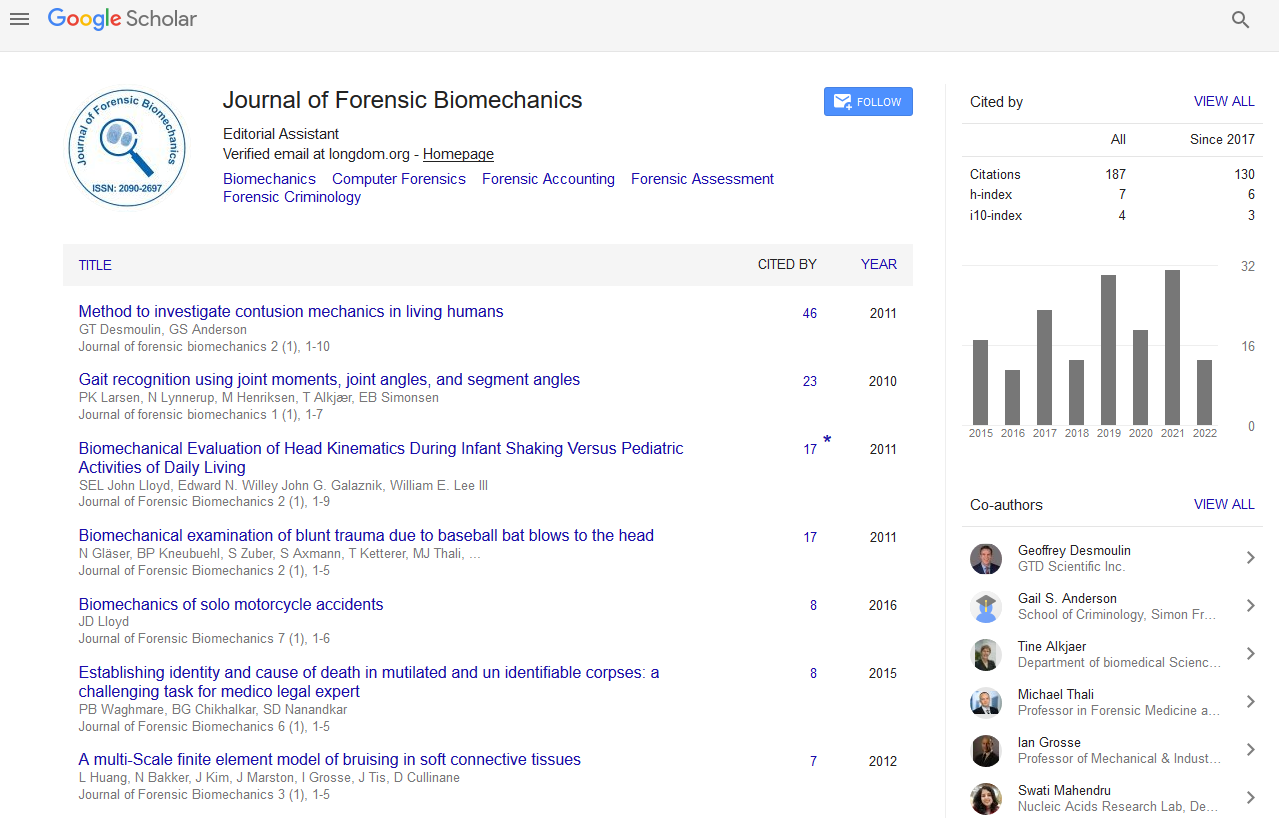Indexed In
- Genamics JournalSeek
- SafetyLit
- Ulrich's Periodicals Directory
- RefSeek
- Hamdard University
- EBSCO A-Z
- Geneva Foundation for Medical Education and Research
- Euro Pub
- Google Scholar
Useful Links
Share This Page
Journal Flyer

Open Access Journals
- Agri and Aquaculture
- Biochemistry
- Bioinformatics & Systems Biology
- Business & Management
- Chemistry
- Clinical Sciences
- Engineering
- Food & Nutrition
- General Science
- Genetics & Molecular Biology
- Immunology & Microbiology
- Medical Sciences
- Neuroscience & Psychology
- Nursing & Health Care
- Pharmaceutical Sciences
Perspective - (2024) Volume 15, Issue 3
Applications of Forensic Biomechanics in Legal Investigations and Injury Analysis
Tam Wong*Received: 26-Aug-2024, Manuscript No. JFB-24-27328; Editor assigned: 29-Aug-2024, Pre QC No. JFB-24-27328 (PQ); Reviewed: 12-Sep-2024, QC No. JFB-24-27328; Revised: 19-Sep-2024, Manuscript No. JFB-24-27328 (R); Published: 26-Sep-2024, DOI: 10.35248/2090-2697.24.15.493
Description
Forensic biomechanics is an interdisciplinary field that applies principles of biomechanics to legal cases particularly those involving injuries accidents and product failures. By analyzing how forces affect the human body experts can reconstruct events leading to injuries offering critical insights in legal contexts. This essay explores several case studies that highlight the practical application of forensic biomechanics illustrating its importance in the justice system.
One common scenario in which forensic biomechanics plays a essential role is slip and fall accidents. For example consider a case where an individual slipped on a wet floor in a grocery store and claimed severe injuries as a result. To investigate a forensic bio mechanist analyzed the conditions of the floor and the mechanics of the fall. Using tools such as force plates and motion capture technology the bio mechanist was able to simulate the fall under similar conditions. They measured the coefficient of friction of the floor and analyzed the body’s dynamics during the slip. The findings revealed that the plaintiff's gait and footwear contributed significantly to the incident which led to a settlement that reflected shared responsibility. This case underscores how biomechanics can clarify the circumstances of accidents allowing for a fair assessment of liability.
Motor vehicle accidents are another area where forensic biomechanics is invaluable. In one case involving a rear-end collision the plaintiff claimed that the impact caused a significant spinal injury. Forensic biomechanics assessed the crash dynamics by reconstructing the collision using computer simulations and physical models. They analyzed the vehicle's speed the angles of impact and the pre-crash positioning of the vehicles involved. Additionally the bio mechanist examined the kinematics of the occupant's body during the crash considering factors such as seat belt usage and the position of the headrest. Their analysis concluded that the forces exerted during the collision were insufficient to cause the alleged injury ultimately supporting the defense’s argument.
Forensic biomechanics is also pivotal in product liability cases. In one instance a consumer was injured while using a power tool that allegedly had a design flaw. The plaintiff argued that the tool's handle was ergonomically unsound leading to repetitive strain injuries. To investigate biomechanical experts conducted ergonomic assessments and analyzed the forces exerted on the body during typical use of the tool. They employed models to simulate different usage scenarios and measured the stress placed on various body parts. Their findings revealed that while the tool's design could be improved the injuries were exacerbated by improper usage techniques rather than a clear defect in the product itself. This conclusion helped the jury understand the complexities involved in product liability emphasizing the need for responsible use alongside sound design.
Forensic biomechanics also finds applications in sports-related injury cases. In one scenario a college athlete sustained a severe knee injury during a football game and claimed that poor field conditions and inadequate safety measures contributed to the injury. Biomechanical analysis involved studying the athlete's movement patterns during the play and the specific forces acting on the knee at the time of injury. By examining video footage and using motion analysis software experts were able to recreate the incident and identify the critical moments leading to the injury. The biomechanical evidence revealed that the injury was primarily due to an unexpected change in direction and not solely due to the field conditions. This finding helped clarify responsibility and informed future safety protocols for athletes.
Forensic biomechanics serves as a essential tool in legal investigations providing scientific insights that clarify complex cases involving human movement and injury. Through detailed analysis and reconstruction of events experts in this field offer valuable evidence that can influence the outcomes of trials. Whether in slip and fall cases motor vehicle accidents product liability claims or sports injuries the applications of forensic biomechanics demonstrate its indispensable role in the pursuit of justice.
Citation: Wong T (2024). Applications of Forensic Biomechanics in Legal Investigations and Injury Analysis. J Forensic Biomech. 15:493.
Copyright: © 2024 Wong T. This is an open-access article distributed under the terms of the Creative Commons Attribution License, which permits unrestricted use, distribution, and reproduction in any medium, provided the original author and source are credited.

